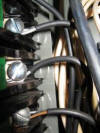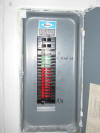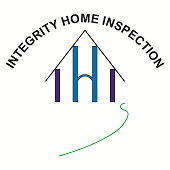Construction Issues
All of the issues noted below may cause the insurance company to refuse coverage on a home, thus causing a problem when it comes time for closing because the Mortgage company requires the home to be insured. We are providing this information to help you to recognize these issues in advance, however if you have any questions, please give us a call.
Click on any of the items below to jump to that page:
_____________________
Aluminum Wiring
The wire itself is not bad -
what is bad is where the wire meets up with the receptacle. Aluminum
expands when it gets hot and contracts when it cools down. Over the
years this expansion and contractor makes the connection to the
receptacle loose. What then happens is that the wire starts to arc
because the connection is not tight. Think of your spark plugs in
your cars engine. Also the wire itself starts to vibrate every so
slightly but under heavy load it can get hot - really hot. It is not
uncommon to open up the face place and see a black electrical box
and that the wire shielding / insulation burnt right off. The issue
of aluminum wiring is not a myth or just a money grab on the part of
your local electrician - it is real.
Solution:
Most expensive is to replace all the wire. The least expensive is to
replace all the connections with COPALUM connectors, Alumiconn
connectors or replacing the outlets, breakers and switches with
those that are designed to accept aluminum wiring.
Contact your local electrician for more information and current
pricing on this issue.

Stab-Lok Electric Panels
The manufacturer of Federal Pacific Stab-Lok
Panels has determined that these panels and breakers have a
significant failure rate. Failure to trip properly with overload and
short-circuiting, are the basic safety defects of this panel. In
over one-third of the panels tested, breakers would not trip when
overloaded. The word Stab-Lok is typically on the label at the top
of the panel as shown in the picture or in the middle of the second
type panel.
Solution: Unfortunately the only
solution is to replace the panel. Cost can run anywhere from $600 to
$1200 for a 150 amp panel, depending on the location. Contact your
local electrician for more information and current pricing on this
issue.


Sylvania Zinsco Electric Panels
Zinsco panel (Sylvania or GTE-Sylvania) panel
testing has shown that the circuit breakers do not trip about 25% of
the time when exposed to overcurrent, risking overheating,
fire and other hazards. The failure rate in the competition was less
than 1%.
Solution: Unfortunately the only
solution is to replace the panel. Cost can run anywhere from $600 to
$1200 for a 150 amp panel, depending on the location. Contact your
local electrician for more information and current pricing on this
issue.

Polybutylene Water Piping
Polybutylene (PB) piping is a grey pipe with
copper or black press-on fittings (see picture below) that can be
identified by the lettering "PB 2110" stamped on the side of the
piping. The problem with PB piping is that the connections are
crimped on the pipe, creating a secure connection at the time the
piping is installed. Over time, chemicals in the water break down
the PB plastic at the connections causing the connections to become
loose and blow apart, thus allowing a full stream of water to enter
the home wherever the failure occurs. Think of a garden hose running
in you attic and you will understand the magnitude of the issue.
Solution: Unfortunately the only solution is to replace the piping.
Costs can run from $2000 and up depending on the size and complexity
of the home. Contact your local plumber for more information and
current pricing on this issue.

![]()
Chinese Drywall
Chinese drywall was imported into the US beginning
in 2001, with the heaviest usage between 2004 and 2008. As of May of 2014,
it was found that chemicals found in Chinese drywall can corrode
pipes and wiring. The US Agency for Toxic Substances and
Disease stated that "The modeling data suggests that levels of
hydrogen sulfide and other sulfur compounds found in the Chinese
manufactured drywall were sufficiently high to result in the health
effects people have been reporting", which includes headaches,
irritated and itchy eyes, dizziness, sore throat, difficulty
breathing, persistent cough, bloody or runny nose, sinus infections
and asthma attacks. Although you may be able to find
labeling on the back of the drywall in the attic that says made in
China, the only way to tell if the drywall is the "bad" type is
laboratory testing.
The indications of Chinese drywall are:
1)
Metal corrosion or blackening of metal items (wiring and copper
piping) within the walls or protruding from the walls.
2) Rotten
egg smell within the home
3) Frequent failures of AC units and
other appliances and electronics
Solution:
Unfortunately the only solution is to replace all the drywall and
subsequent damages in the house.
More information can be found here about the health effects of Chinese drywall
What is Chinese Drywall and why is it important? (Wikipedia)
Roofs
According to Citizens Insurance, any home which is
older than 25 years old and has asphalt shingles, must be able to
prove that a new roof has been installed since it was built. Any
roof over 50 years old with a tile roof, must be able to prove that
a new roof has been installed.
Although there are a few
exceptions, in Florida the typical life expectance for shingles are
as follows:
3-tab Asphalt Shingles
16 years +/- 1 Depending on quality
Architectural Asphalt Shingles
19 years +/- 2 Depending on quality
**In general, Insurance companies will
typically not cover a roof with less than 3 years of life left.
**For wind mitigation in certain cities, the trend is toward
only keeping records for 10 years. The problem with this is
that the State of Florida Wind Mitigation Form requires a Permit
Application date for a roof if the roof was installed after
3/1/2002. Unfortunately this information is not kept after 10 years
so it becomes very difficult to provide the permit application date
as required by the form. For roofs installed in 2002 and 2003, the
data no longer exists in their regular database. Sometimes they can
find the information in their inspectors files so it takes a few
days to determine what's available.
According to the National Electric Code (NEC) 406.3 (D) (3) (B) 2 prong outlets can be replaced with GFCI outlets for occupant protection. This does not ground the outlet but it does make them safe for the occupants. (Click here for excerpt)


Connect With Us
Contact us today for your Inspection - 866-340-1325